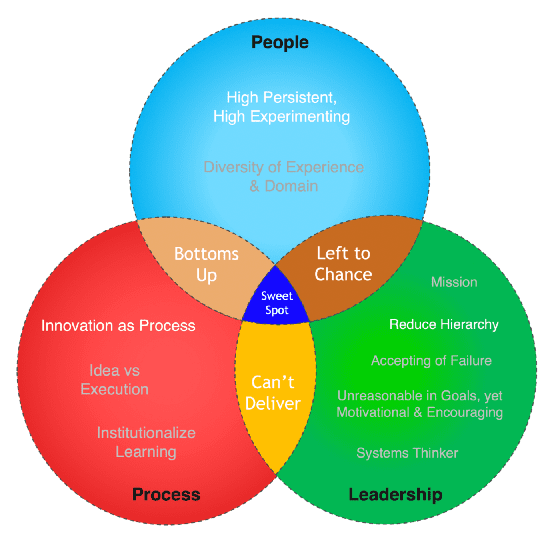How to foster innovation as your business changes
Dr. Dennis Khoo breaks his innovation ideas down into chunks for businesses going through change.
Why You Should Care
Experiment and persist. Make it a process. Reduce hierarchy.
Dig into these three ideas in Dr. Khoo's look at innovation techniques for UNLEASH.
Fostering innovation is a key task that is very hard to delegate. Business leaders need to ensure that the three important ingredients of people, process and leadership, which are required to create a great environment that fosters innovation, are strongly present.
Organizations that focus on people and process without significant leadership emphasis on innovation can still succeed but only if they focus on fundamental deep-science innovation that is bottom-up in nature, e.g. building a better jet engine.
On the other hand, with strong leaders that foster innovation but have poor innovation processes, you mostly leave innovation to chance.
Finally if you have the process and the leadership, and don’t have innovative people, then you obviously can’t deliver on your innovation.
This piece focuses on one factor in each key ingredient of people, process and leadership.

People – identifying staff who are high in persistence and experimentation
You naturally can’t deliver any innovation without people. The key question is, how do you identify people who are innovative and recruit them into your team?
The answer is by looking for people who are highly persistent and highly experimental. To be innovative, there must be a good balance of persistence and experimentation.
If your key staff charged with innovation are persistent but low on experimenting, they tend to use the same approach without modification, even though it is obvious that the path taken is not yielding results.
On the other hand, if experimentation is high and persistence is low, people tend to move quickly to some other approach or idea they think is novel, without the persistence to see any one idea through.
So, to be inventive, your team needs to have both traits equally, so they can use one or the other or both together, if needed.
Process – treating innovation as a process
Having a diverse team who are highly persistent and highly experimental is one piece of the innovation puzzle. When joined with another piece of the puzzle – having the right processes – both pieces fit neatly together and offer a higher probability of success.
Process is the next ingredient; crucial to innovation and can increase the probability of successful execution. One of the ironies is that creative people are often poor at process. But innovation requires creativity because “creativity is the process of bringing something new into being” (Rollo May).
To bridge this gap, leaders must ensure equal emphasis on creativity and process. Understanding key business processes also helps business leaders understand the interconnected and nature of complex problems.
These innovation processes also help to ensure that properly thought-through ideas make it to the next level of filter, hopefully with the most obvious and glaring mistakes caught before the launch. Thus, they help to ensure better ideas float to the top and get acted on.
And, as innovation is not a one-time event but a continuous process of learning and refinement, it is also important to capture these observations, insights and learnings, so that you are constantly improving the probability of success.
Without the right processes in place, you can still be innovative, but there is a higher likelihood that you leave things to chance, as shown in the graphic.
Leadership – reducing hierarchy
Many companies are hierarchical. The point is not that a flat or zero hierarchy environment is always better for innovation.
The point about hierarchy is that it blunts challenge. And without challenge, the best thoughts don’t float to the top because sufficient challenge is required for the best ideas to survive.
Much research on this topic has found that hierarchy has merits in the selection of ideas for onward progress towards innovation but is less effective in the origination of novel ideas that feed the former process (Bunderson & Sanner, 2018; Keum & See, 2017).
There is a very simple way to reduce hierarchy in your organization: Create an environment where curiosity is valued and promote this ethos relentlessly.
For example, you should constantly emphasize the need for everyone to question and ask ‘why’. Try this unwritten rule: the most senior person in a meeting room has to answer the most junior person’s ‘why’.
This simple act reduces hierarchy, as it signals that no matter your seniority, your thoughts are open to challenge, which means more robust debates and better decisions.
It is extremely important that the C-Suite creates an environment where everyone knows that there is no penalty for proper and well-thought views and opinions that are different from those of more senior colleagues in the discussion phase.
At the same time, it is critical that leaders protect the environment from any individual whose behaviors run against the values needed for this culture to thrive. This creates a situation where highly grounded viewpoints and opinions can be sourced throughout the organization. This is hard to achieve as the penalty for opposition of authority may not be visible but is nevertheless often perceived as fatal to one’s career.
Only by repeated reinforcement and exemplification can one achieve such an environment. It does not mean that if there are two equally good arguments that the leader cannot select the argument they favor.
It simply makes the selection of an inferior approach or position much more difficult, which helps to ensure that decisions are well-debated and considered most of the time.
Sign up to the UNLEASH Newsletter
Get the Editor’s picks of the week delivered straight to your inbox!

Author and speaker
Dr. Dennis Khoo is a keynote speaker and the creator of the first digital bank in ASEAN.
